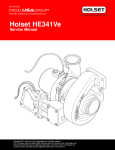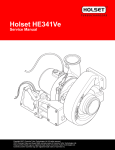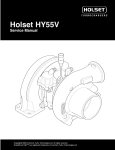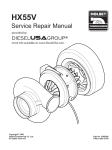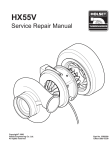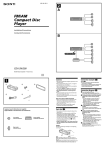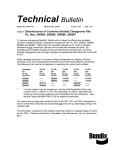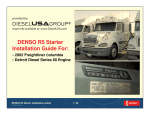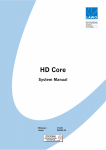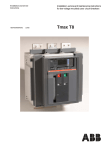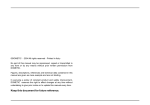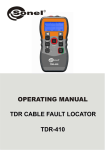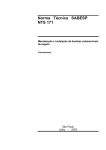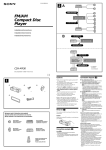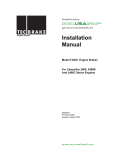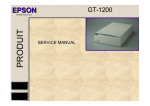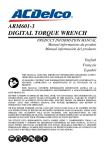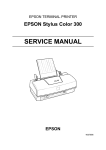Download Holset HE431V Series Turbos
Transcript
provided by: DIESELUSAGROUP® more info available at: www.DieselUSA.com Holset HE431V Service Repair Manual Copyright 2007, Cummins Turbo Technologies Ltd. All rights reserved. VGT, Command Valve and Super MWE are trade marks of Cummins Turbo Technologies Ltd. Holset and the Holset Logo are registered trade marks of Cummins Turbo Technologies Ltd. Cummins and the Cummins logo are registered trade marks of Cummins Inc. HE431V Service Manual from: www.DieselUSA.com Foreword Foreword This publication was written to assist with turbocharger installation, maintenance and overhaul. The specifications and procedures in this manual are based on information in effect at the time of publication. Holset Service reserves the right to make any changes at any time without obligation. If differences are found between your turbocharger and the information in this manual, contact your local Holset approved agent. The latest technology and the highest quality standards are used in the manufacture of Holset Turbochargers. When replacement parts are needed, we recommend using only genuine Holset parts. HE431V Service Manual from: www.DieselUSA.com Table of Contents Table of Contents 1: Introduction About the Manual . . . . . . . . . . . . . . . . . . . . . . . . . . . . . . . . . . . . . . . . . . . . . . . . . . . . 1:1 How to Use the Manual. . . . . . . . . . . . . . . . . . . . . . . . . . . . . . . . . . . . . . . . . . . . . . . . 1:1 How to Order Holset Original Parts. . . . . . . . . . . . . . . . . . . . . . . . . . . . . . . . . . . . . . . 1:1 Description and Operation of Turbocharger . . . . . . . . . . . . . . . . . . . . . . . . . . . . . 1:2 General Information . . . . . . . . . . . . . . . . . . . . . . . . . . . . . . . . . . . . . . . . . . . . . 1:2 Introduction to Variable Geometry Turbochargers . . . . . . . . . . . . . . . . . . . . . . 1:2 Notes, Cautions and Warnings . . . . . . . . . . . . . . . . . . . . . . . . . . . . . . . . . . . . . 1:4 Installation Data . . . . . . . . . . . . . . . . . . . . . . . . . . . . . . . . . . . . . . . . . . . . . . . . . . . . 1:6 Installation Checklist . . . . . . . . . . . . . . . . . . . . . . . . . . . . . . . . . . . . . . . . . . . . . . . . 1:7 Symbols . . . . . . . . . . . . . . . . . . . . . . . . . . . . . . . . . . . . . . . . . . . . . . . . . . . . . . . . . . . 1:8 2: Component Identification Turbocharger Identification . . . . . . . . . . . . . . . . . . . . . . . . . . . . . . . . . . . . . . . . . . . 2:1 Dataplate . . . . . . . . . . . . . . . . . . . . . . . . . . . . . . . . . . . . . . . . . . . . . . . . . . . . . . 2:1 Installation Options . . . . . . . . . . . . . . . . . . . . . . . . . . . . . . . . . . . . . . . . . . . . . . 2:2 Exploded View . . . . . . . . . . . . . . . . . . . . . . . . . . . . . . . . . . . . . . . . . . . . . . . . . . . . . . 2:3 Component List . . . . . . . . . . . . . . . . . . . . . . . . . . . . . . . . . . . . . . . . . . . . . . . . . . . . . 2:4 3: Troubleshooting and Diagnosis Fault Finding Charts . . . . . . . . . . . . . . . . . . . . . . . . . . . . . . . . . . . . . . . . . . . . . . . . . 3:1 4: Component Testing and Replacement Service Tools . . . . . . . . . . . . . . . . . . . . . . . . . . . . . . . . . . . . . . . . . . . . . . . . . . . . . . . 4:1 On Engine Checks . . . . . . . . . . . . . . . . . . . . . . . . . . . . . . . . . . . . . . . . . . . . . . . . . . 4:3 Bearing Clearance. . . . . . . . . . . . . . . . . . . . . . . . . . . . . . . . . . . . . . . . . . . . . . . . . . . 4:7 VG Actuator Checks . . . . . . . . . . . . . . . . . . . . . . . . . . . . . . . . . . . . . . . . . . . . . . . . . 4:8 VG Actuator Removal and Checks. . . . . . . . . . . . . . . . . . . . . . . . . . . . . . . . . . . . . 4:10 VG Actuator Replacement. . . . . . . . . . . . . . . . . . . . . . . . . . . . . . . . . . . . . . . . . . . . 4:12 VG Actuator Replacement Check . . . . . . . . . . . . . . . . . . . . . . . . . . . . . . . . . . . . . . 4:13 Speed Sensor Check and Removal . . . . . . . . . . . . . . . . . . . . . . . . . . . . . . . . . . . . 4:14 Speed Sensor Replacement . . . . . . . . . . . . . . . . . . . . . . . . . . . . . . . . . . . . . . . . . . 4:16 Dcon Control Valve . . . . . . . . . . . . . . . . . . . . . . . . . . . . . . . . . . . . . . . . . . . . . . . . . 4:17 Icon Control Valve . . . . . . . . . . . . . . . . . . . . . . . . . . . . . . . . . . . . . . . . . . . . . . . . . . 4:18 6: Service Data Sheets VG Range Service Data Sheets . . . . . . . . . . . . . . . . . . . . . . . . . . . . . . . . . . . . . . . . 6:1 HE431V Service Manual from: www.DieselUSA.com Introduction About the Manual The procedures in this manual were developed to instruct in the correct overhaul of the designated Holset turbochargers for optimum performance and minimum maintenance operation. How to Use the Manual The manual is split into sections designed to provide service information in a logical sequence. The manual contains links to help the user navigate between relevant sections. Users who are unfamilier with navigating in PDF documents are refered to Navigating in PDF documents in the Adobe® Acrobat® Reader™ help file. Contents is an interactive page with links to all the sections. It can be accessed from any page in the manual by clicking this icon. Section 1 defines the layout of the manual, introduces the reader to the operation of the turbocharger and presents important installation guidelines. Sections 2, 3 and 4 concentrate on Turbocharger Component Identification, Troubleshooting and Diagnosis, Component Testing and Replacement. Section 5 identifies the Service and Overhaul procedures to be followed in the unlikley event of a major turbocharger malfunction. (This section is not available for this turbocharger range at the present time) Section 6 quantifies build data to ensure the turbocharger will continue to operate to Holset Service standard on completion of overhaul. Manual sections 1 to 5 where applicable, appear as a self extracting compressed file which is organised according to the steps needed to most easily and correctly maintain the operation of the turbocharger. Users are required to download this file to hard disk. Section 6 has its own file identity and resides at www.holset.co.uk. so that Holset can update the Service Data as changes occur. The links between manual and service data are active only when the user is connected to the Internet. Chapter 6 has an expiry date to encourage users to discard outdated saved or printed versions and always access the latest information available at www.holset.co.uk. When using the manual on-line this icon will link to Holset’s website to help find your nearest agent for advice and how to order Holset original parts. How to Order Holset Original Parts To make sure of optimum performance, certain items must be discarded during disassembly and replaced with new for re-assembly. These items are indicated in the Service and Overhaul section with the use of a symbol. All items showing a are available in a basic overhaul kit. * * To get the correct parts for your turbocharger, refer to the ‘component identification’ section of this manual to help you find the following information: 1) Refer to the exploded view and component list to define the major components to be replaced. 2) Refer to the turbocharger’s dataplate which will be found on the compressor housing or actuator to define the identifying information about your turbocharger build standard. 3) Contact your local Holset agent with componant identification nos. and dataplate assembly no., serial no. and turbocharger type. 4) With this information, your local agent can provide you with the optimum kit of parts for re-assembling your turbocharger for continued long life operation. 1:1 HE431V Service Manual from: www.DieselUSA.com Introduction Description and Operation of Turbocharger General Information A turbocharger is a mechanical device which uses the engine’s exhaust gases to force more air into the engine cylinders. Hot exhaust gas energy is used to turn a turbine wheel and shaft. At the other end of the shaft is the compressor impeller (or compressor wheel), which draws in air and forces it into the engine cylinders. Supplying increased air mass flow to the engine provides improved engine performance, lower exhaust smoke density, improved operating economy and altitude compensation. The turbocharger has proven to be one of the most beneficial devices for improving engine performance. It performs its job very well, as long as it is properly cared for. Introduction to Variable Geometry Turbochargers (VGT™) The Need for Variable Geometry The turbocharger on your vehicle’s engine is of a very advanced type, which varies the effective size of its turbine in response to the driver’s demands. Under all conditions of driving, the turbine is electronically controlled to change the amount of air supplied to the engine, to ensure maximum performance, lowest fuel consumption and minimum exhaust emission levels. When rapid vehicle acceleration is required, the turbocharger will produce air for the engine more quickly than a conventional unit, thus eliminating turbocharger lag and giving improved vehicle drivability. As the engine and turbocharger run in, and eventually start to wear, the combination of the variable turbine and its associated electronic control, will change its characteristic to keep to the original performance and emission levels over a wide range of ambient temperatures and altitude. The Importance of Correctly Installing a Variable Geometry Turbocharger (VGT™) The bearing housing of your turbocharger contains an internal water-cooled jacket. The purpose of this is to reduce the operating temperature of the housing, to improve the operating environment of the speed sensor and reduce the high soak temperatures produced when the engine is switched off after being heavily loaded. The addition of water cooling has meant that there are two extra pipe connections to the turbocharger, to bring water to the housing and to take it away. It is important to observe the correct installation of these pipes, so that the circulation of the water is in the correct direction, or the effectiveness of the cooling system will be lost and severe damage may result. The Importance of Correct Operation of a Variable Geometry Turbocharger (VGT™) A variable geometry turbocharger is controlled by the engine control module to optimise engine air fuel ratio for performance and emissions. A malfunction may cause a mismatch between air and fuel supply which could lead to progressive engine damage. It is important that any operating symptom which indicates incorrect turbocharger operation is dealt with immediately by taking the unit safely out of service. 1:2 from: www.DieselUSA.com HE431V Service Manual Introduction The Advantages of a Variable Geometry (VGT™) Turbocharging System You may already have experience of the effect of a Wastegate turbocharger on the performance of your vehicle. The advantage of Variable Geometry over a Wastegate system is that all the exhaust gas flows through the turbine wheel to increase net turbine power output. In addition, turbine power can be set to provide just sufficient energy to drive the compressor at the desired boost level wherever the engine is operating. Speed and pressure sensors feedback information to the Engine Control Module to provide the necessary control As the name suggests a Wastegate turbocharger allows exhaust gas to by-pass the turbine wheel. This bypassed gas contains energy which is lost to the turbine wheel. Wastegate turbochargers have no feedback controls. Pneumatic Control Cylinder Control Air Exhaust Gas Speed Sensor Fixed Shroud Plate Air Inlet Turbine Compressor Boost Air Outlet Operating Yoke Push Rods and Bushes Sliding Nozzle Ring and Vanes The Holset Variable Geometry Turbine (VGT™) system works by controlling the width of a nozzle guiding the gas flow into the turbine wheel. Control is achieved using an air supply from the vehicle’s auxiliary air reservoir. The Engine Control Module modulates the supply pressure to the turbocharger pneumatic control cylinder (actuator) which acts on a rod and yoke system to slide the nozzle ring and blades relative to the fixed shroud plate. This movement varies the area through which exhaust gas enters the turbine wheel blades. Pneumatic Actuator Control Air Pressure Sensor (Optional) Air Tank Shut off Valve Control Valve Electrical Control Line Engine Speed Engine Control Module (ECM) Throttle Demand Inlet Manifold Pressure & Temperature Exhaust Manifold Pressure Fuel Injection Pump Information Ambient Pressure & Temperature Contains pre-set data on airflow requirements for any fuel quantity injected at any engine speed, with built-in safety features for excessive boost, smoke or turbocharger speed. Exhaust Outlet Pressure Turbocharger Speed 1:3 HE431V Service Manual from: www.DieselUSA.com Introduction Notes, Cautions and Warnings Notes, Cautions and Warnings are used in this manual to emphasise important or critical instructions. Note Information which is essential to highlight. Caution Maintenance or Service procedures which if not strictly followed, will result in damage or destruction of the turbocharger. Warning Maintenance or Service procedures which if not correctly followed will result in personal injury or loss of life. Warning The designated turbochargers weigh up to 22.5 kg (49 lb). When lifting the turbocharger manually always get assistance to avoid back strain or dropping the unit and consequential injury. External parts include electrical wiring and connectors which are sensitive to handling. Some models are fittedwith titanium compressor wheels which have sharp edges and should be handled with care. Warning Some parts are manufactured in fluoroelastomers (eg Viton) or similar that require special treatment in the case of repair and service after fire. Warning Turbocharger surface temperature during operation can achieve 700°C (1300°F). Caution Orientation of the turbine housing of a variable geometry turbocharger is factory set. Any attempt to re-orientate the housing can cause severe damage to the VG mechanism and may void warranty. Caution This variable geometry turbocharger has been factory balanced using the core balance process. Service overhaul/repair must be carried out by Holset Engineering to ensure the variable geometry system is correctly rebuilt. It is important to note that operating a turbocharger with rotor or core balance level greater than design limits could cause turbocharger or engine failure. Caution In the event of a suspected variable geometry turbocharger malfunction, symptoms which may include low power and black smoke, it is important to avoid potential progressive engine damage. The vehicle should be taken out of service and towed to an appropriate repair facility as soon as this can be accomplished without sacrificing the safety of the operator and/or passengers. 1:4 HE431V Service Manual from: www.DieselUSA.com Introduction Notes, Cautions and Warnings Note Holset turbochargers can be remanufactured using recovered parts. Where it is necessary to dispose of components or whole turbochargers, an environmentally responsible process such as recycling should be used, with due regard to local laws. Note Holset Service receives many turbocharger returns that are no fault found. Before assuming the turbocharger is not performing to specification always refer to the engine diagnostic system and the troubleshooting diagnostic procedures of this manual. 1:5 HE431V Service Manual from: www.DieselUSA.com Introduction Installation Data 1. Holset Service receives many turbocharger returns that are no fault found. Before assuming the turbocharger is not performing to specification always refer to the engine diagnostic system and the fault finding chart of this manual to make all the recommended health checks. 2. It is important that intake and exhaust systems are fitted in accordance with the recommendations of the Equipment and Engine manufacturers. It is important not to overload the turbocharger by external attachments or forces. 3. The air filter must remove particles greater than 5 µm at an efficiency of 95%and be of sufficient capacity to match the air consumption of the engine. Recommended filters should always be used with a pressure drop indicator. Intake systems must be tightened to the values specified by the Equipment and Engine manufacturers to withstand depressions up to 6.3 kPa (0.91 lbf/in2) 4. Hose and clip connections of intake manifold systems must be capable of withstanding the turbocharger pressure ratio. V-band clamps are preferred and must be used above 3:1 pressure ratio. 5. Exhaust system connections must be tightened to the values specified by the Equipment and Engine manufacturers to be capable of operating at exhaust back pressures of up to 10 kPa (1.5 lbf/in2). Subject to an extensive review by Holset and formal approval, this limit may be increased to 25 kPa (3.6 lbf/in2) if a catalytic convertor is fitted. Exhaust brake applications are permitted to operate at a continuously rated pressure up to 450 kPa (65.3 lbf/in2) Holset has experience of instantaneous pressures up to 700 kPa (101.5 lbf/in2) but any application operating above 450 kPa (65.3 lbf/in2) must be referred to Holset for approval. 6. Oil should be filtered to 10 µm with efficiency of 60% TWA (Time Weighted Average) /20 µm with efficiency of 85% TWA. Efficiency assessed using ISO Standard 4572/SAE J 1858. Always use filters recommended by the engine manufacturer. 7. The oil quality must be as specified by the engine manufacturer and will be a minimum API - CD (MIL L - 2104C) specification. Improvement in life can be obtained by using super high performance diesel (SHPD) oils, particularly where extended oil drain periods are used. 8. Normal oil temperature is 95+/-5 °C (203+/-9 °F). It should not exceed 120 °C (248 °F) under any operating condition. 9. Any pre-lube oil must be clean and meet the minimum CD classification. 10. The orientation of turbine housing and bearing housing of a VG turbocharger is fixed. During installation, do not attempt to rotate these components, as it may affect the operation of the VG actuating mechanism and may void any warranty. 11. Holset permits oil drain pipes to decline at an overall angle of not less than 30 degrees below horizontal. These turbochargers require a drain pipe of 19 mm internal diameter minimum which has integrated connectors. To ensure oil drains into the engine under all operating conditions the return connection into the engine sump must not be submerged. 12. Crankcase pressure should be limited to 0.8 kPa (0.12 lbf/in2). Pressure above this level should be referred to Holset for further evaluation. Closed crankcase ventilation (CCV) systems are known to operate at elevated pressure and all applications must be referred to Holset for approval. 13. Oil pressure must show at the turbocharger oil inlet within 3 - 4 seconds of engine firing to prevent damage to turbocharger bearing system. A flexible supply pipe is recommended. 14. The minimum oil pressure when the engine is on load must be 210 kPa (30 lbf/in2). Normal maximum operating pressure is 400 kPa (58 lbf/in2) although 600 kPa (88 lbf/in2) is permitted during cold start up. Under idling conditions pressure should not fall below 70 kPa (10 lbf/in2). 15. Recommended oil flow ranges for these turbochargers are 2 - 3 litre/min at idle and 3.5 - 4.5 litre/min at maximum engine speed. 16. Recommended coolant flows for these turbochargers are 3 litre/min at idle and 14 litre/min at maximum engine speed. Coolant hose design must permit flow to increase progressively with engine speed. 17. Do not use liquid gasket substances or thread sealant as any excess can enter the turbocharger oil and coolant systems to obstruct flow. Note: 100 kPa = 1 bar (14.5037 lbf/in2 = psi). 1:6 HE431V Service Manual from: www.DieselUSA.com Introduction Installation Checklist 1. Always understand why the original turbocharger needs replacing before fitting another unit. 2. Check the turbocharger dataplate to ensure the Part No. is correct for the engine/application. 3. Check the engine exhaust, intake and aftercooler systems are clean and without obstruction i.e. free from oil, gasket pieces, dust/dirt/carbon or foreign objects. 4. Replace the oil and air filters using replacement parts specified by the equipment manufacturer. 5. Change the engine oil using the type specified by the engine manufacturer. 6. Check that the turbocharger oil inlet and drain pipes and connectors are clean, free from obstruction and will not leak under pressure. Before re-installing flexible pipes always ensure any burnt-on lacquer or other adhered material is removed from internal bores. If in doubt, always fit new pipes. 7. Check that the coolant pipes of water cooled bearing housing applications and connectors are clean, free from obstruction and will not leak under pressure. 8. To pre-lube the turbocharger bearings, pour some clean engine oil into the oil inlet and rotate the turbocharger rotor assembly by hand. 9. Check that the exhaust manifold flange is flat and undamaged. Mount the turbocharger on the flange and check that the turbine inlet gasket fits properly without obstructing the gas passages. 10. Assemble the air intake and boost outlet connections. Check that the connections are secure and will not leak in use. 11. Check the exhaust system is fitted using the original mounting arrangement provided by the equipment manufacturer. Always re-fit any supports/brackets back in position to ensure the system is correctly supported. 12. Assemble the exhaust system to the turbine housing outlet. Check that the gasket/connection is secure and will not leak in use. 13. Assemble any coolant pipes and check that the connections are secure, without obstruction and will not leak in use. 14. Assemble the turbocharger oil inlet pipe and check that the connection is clean, secure and will not leak in use. 15. Check all clamps and fasteners are correctly tightened to the torque recommended by the equipment manufacturer. 16. Make the electrical connections between VG sensors and engine control module (ECM). Check the electrical connection between control valve and ECM. 17. Check the air connection between the vehicle auxiliary tank and control valve. 18. Connect the air pipe from the control valve to the actuator ensuring the pipe bore is clean and dry before fitment. 19. Make any ECM checks recommended by the engine manufacturer. 20. Crank the engine WITHOUT firing until engine oil flows out of the turbocharger drain flange. 21. Assemble the oil drain pipe and check that the connection is secure, without obstruction and will not leak in use. 22. Start the engine and run at idle speed for approximately 1 minute so that the oil supply system is fully operational. 23. Accelerate the engine and check that there are no leaks/obstructions of air/oil/coolant/gas under pressure. 24. Check that no hose or connection deforms under normal operation. 25. Before switching off the engine, leave it running at idle speed for at least 1 minute to cool the turbine. 1:7 HE431V Service Manual from: www.DieselUSA.com Introduction Symbols Symbole - Deutsch In diesem Handbuch werden die folgenden Symbole verwendet, die wesentliche Funktionen hervorheben. Die Symbole haben folgende Bedeutung: WARNUNG - Unterhaltungs und Wartungsverfahren müssen genau befolgt werden, da ein Nichtbeachten zu Personenschäden oder tödlichen Verletzungen führt. ACHTUNG - Falls Unterhaltungs und Wartungsverfahren nicht genau beachtet werden, kann der Turbolader dadurch beschädigt oder zerstört werden. AUSBAU bzw. ZERLEGEN. EINBAU bzw. ZUSAMMENBAU. INSRPEKTION erforderlich. Teil oder Baugruppe REINIGEN. DIMENSION - oder ZEITMESSUNG. Teil oder Baugruppe ÖLEN. WERKZEUGGRÖSSE wird angegeben. ANZUG auf vorgeschriebenes Drehmoment erforderlich. Sicherstellen, daß die AUSWUCHTMARKEN an der Rotor-Baugruppe richtig ausgerichtet sind. Elektrische MESSUNG DURCHFÜRHREN. Weitere Informationen an anderer Stelle bzw. in anderen Handbüchern. Schutzkleidung muß immer getragen werden. KG Deutet an, daß Teile schwer sein können. Website-Verzeichnis mit Ihrem nächsten Holset-Händler. Gehe zu Inhalt 1:8 HE431V Service Manual from: www.DieselUSA.com Introduction Symbols - English The following group of symbols have been used in this manual to help communicate the intent of the instructions. When one of the symbols appears, it conveys the meaning defined below. WARNING - Serious personal injury or extensive property damage can result if the warning instructions are not followed. CAUTION - Minor personal injury can result or a part, an assembly or the engine can be damaged if the caution instructions are not followed. Indicates a REMOVAL or DISASSEMBLY step. Indicates an INSTALLATION or ASSEMBLY step. INSPECTION is required. CLEAN the part or assembly. PERFORM a mechanical or time MEASUREMENT. LUBRICATE the part or assembly. Indicates that a WRENCH or TOOL SIZE will be given. TIGHTEN to a specific torque. Ensure that the BALANCE MARKS on the rotor assembly are in alignment PERFORM an electrical MEASUREMENT. Refer to another location in this manual or another publication for additional information. Please wear protective clothing at all times. KG Indicates components may be heavy. Website access to find your nearest Holset Agent. Go to contents 1:9 HE431V Service Manual from: www.DieselUSA.com Introduction Simbolos - Español Los simbolos siguientes son usados en estes manual para clarificar el proceso de las instrucciones. Cuado aparece uno de estos simbolos, su significado se espcifica en la parte inferior. ADVERTENCIA – Procedimientos de Mantenimiento o Servicio que al no seguirse resultarán en daños personales o pérdida de vida. ATENCION – Procedimientos de Mantenimiento o Servicio que al no seguirse al pie de la letra, resultarán en el daño o la destrucción del turbosobrealimentador. Indica un paso de REMOCION o DESMONTAJE. Indica un paso de INSTALACION o MONTAJE. Se requiere INSPECCION. LIMPIESE la pieza o el montaje. Ejecutese una MEDICION mec·nica o del tiempo. LUBRIQUESE la pieza o el montaje. Indica que se dar· una LLAVE DE TUERCAS o el TAMA—O DE HERRAMIENTA. APRIETESE hasta un par torsor especifico. Ceriórese de que est·n alineadas las marcas de balance en el rotor. EJECUTESE una MEDICION eléctrica. Para información adicional refiérase a otro emplazamiento de este manual o a otra publicación anterior. Favor de siempre llevar ropa protectora. KG Indica que los componentes pueden ser pesados. Acceso a Sitio Web para localizar su agente Holset más cercano. Ir a la tabla de materias 1:10 HE431V Service Manual from: www.DieselUSA.com Introduction Symboles - Français Les symboles suivants sont utilisés dans ce manuel pour aider à communiquer le but des instructions. Quand l’un de ces symboles apparait, il évoque le sens défini ci-dessous: ATTENTION DANGER - Procédures de maintenance ou d’entretien qui, si elles ne pas observées correctement, auront pour résultat des lésions corporelles ou un décès. MISE EN GARDE - Procédures de maintenance ou d’entretien qui, si elles ne sont pas observées strictement, auront pour résultat de causer des dégâts au turbocompresseur ou de conduire à sa destruction. Indique une opération de DEPOSE. Indique une opération de MONTAGE. L’INSPECTION est nécessaire. NETTOYER la pièce ou l’ensemble. EFFECTUER une MESURE mécanique ou de temps. GRAISSER la pièce ou l’ensemble. Indique qu’une DIMENSION DE CLE ou D’OUTIL sera donnée. SERRER à un couple spécifique. S’assurer que les repères d’équilibrage sur l’ensemble de rotor sont alignés. EFFECTUER une MEASURE électrique. Se reporter à un autre endroit dans ce manuel ou à une autre publication pour obtenir des information plus complètes. Il faut toujours mettre vêtements de protection. KG Indique que les composants peuvent être lourds. Accès au site Web pour trouver l’agent Holset le plus proche. Aller au sommaire 1:11 HE431V Service Manual from: www.DieselUSA.com Introduction Símbolos - Português Os símbolos a seguir serão utilizados neste manual para facilitar a comunicação das instruções e seue significados estão déscritos abaixo. ATENÇÃO - Os procedimentos de Manutenção ou Serviços que não forem seguidos correctamente resultarão em ferimentos pessoais ou riscos de vida. AVISO - Os procedimentos de Manutenção ou Serviço que não forem rigorosamente seguidos resultarão em danos ou destruição do carregador turbo. Indica um passe de DESMONTAGEM. Indica um passo de MONTAGEM. Requer inspeção. LIMPE a peça ou conjunto. Requer Medição mecãnica ou de tempo. LUBRIFIQUE a peça ou o conjunto. Indica necessidade de APERTO. TORQUEAR de acordo com o especificado. Assegure-se de que as MARCAS DE BALANCEAMENTO do conjunto eixorotor estejam alinhadas. Requer medição ELÉTRICA. Procure em outra seção deste manual ou em publicação par obter informações adicionais Por favor, sempre utilize EPI (Equipamento de Protecao Individual) KG Indica que os componentes podem estar pesados. Visite o Website para encontrar o seu Agente Holset mais perto. Vá para Conteúdo 1:12 HE431V Service Manual from: www.DieselUSA.com Component Identification Turbocharger Identification Dataplate Note The dataplate will be fitted to the compressor housing (8). The information from the dataplate must be quoted for service and parts support. 35XXXXX XYYMMXXXXX HE431V HE431V 2:1 HE431V Service Manual from: www.DieselUSA.com Component Identification Installation Options Type A 2:2 from: www.DieselUSA.com HE431V Service Manual Component Identification Exploded View - HE431V 125 120 112 115 27 105 156 115 92 159 27 27 126 158 27 27 114 103 113 106 114 115 105 115 53 77 129 106 Note Exploded views represent a generic build standard. Parts may be added or subtracted in specific applications. 2:3 HE431V Service Manual from: www.DieselUSA.com Component Identification Component List - HE431V Item No. Description 121 VG Actuator Kit comprising: Quantity 1 126 VG Actuator fitted with: 1 159 Adapter, Air Inlet fitted with: 1 27 O-Ring Seal 2 122 VG Actuator Fittings Kit comprising: 1 92 Roll Pin 1 106 Screw, Actuator 3 77 Retaining Ring, End Link 1 129 Sacrificial Anode 1 123 VG Bearing Housing Seals & Adapter Kit (Water & Oil) comprising: 1 53 Gasket, Oil Outlet 1 113 Adapter, Oil Inlet fitted with: 1 114 O-Ring Seal, Oil Inlet 2 105 Connector Male, Water fitted with: 2 115 O-Ring Seal, Water 4 124 Speed Sensor Kit comprising: 1 112 Speed Sensor 1 120 Cap Head Screw 1 27 O-Ring Seal 1 144 Control Valve 1 156 Bolt 1 158 Temperature Sensor fitted with: 1 27 103 27 O-Ring Seal Pressure Plug fitted with: O-Ring Seal 1 1 1 Note Exploded views may not contain all listed components. 2:4 HE431V Service Manual from: www.DieselUSA.com Troubleshooting and Diagnosis Oil Leak from Turbine Seal Oil Leak from Compressor Seal Cyclic Sound from the Turbocharger Turbocharger Noisy High Oil Consumption Blue Exhaust Smoke Black Exhaust Smoke Engine Lacks Power Smoke Poor Transient Response Engine Running Hot Fault Finding Chart - All Applications Dirty air cleaner Clean or replace element according to manufacturer’s recommendations Restricted compressor intake duct Remove restriction or replace damaged parts as required Restricted air duct from compressor to intake manifold Remove restriction or replace damaged parts as required Restricted intake manifold Refer to engine manufacturer’s manual and remove restriction Air leak in feed from air cleaner to compressor Replace seals, gaskets or tighten fasteners as required Air leak in feed from compressor to intake manifold Replace seals, gaskets or tighten fasteners as required Air leak between intake manifold and engine Refer to engine manufacturer’s manual and replace gaskets or tighten fasteners as required Foreign object in exhaust manifold (from engine) Refer to engine manufacturer’s manual and remove obstruction Restricted exhaust system Remove restriction or replace damaged parts as required Exhaust manifold cracked, gaskets blown or missing Refer to engine manufacturer’s manual and replace gaskets or damaged parts as required Gas leak at turbine inlet/exhaust manifold joint Replace gasket or tighten fasteners as required Gas leak in ducting after turbine outlet Refer to engine manufacturer’s manual and repair leak Restricted turbocharger oil drain line Remove restriction or replace damaged parts as required Restricted engine crankcase breather Refer to engine manufacturer’s manual, clear restriction Turbocharger bearing housing sludged or coked Change engine oil and oil filter, overhaul or replace turbocharger as required Fuel injection pump or fuel injectors incorrectly set Refer to engine manufacturer’s manual and replace or adjust faulty components as required Engine valve timing incorrect Refer to engine manufacturer’s manual for correct settings and adjust as required Worn engine piston rings or liners Refer to engine manufacturer’s manual and repair as required Burnt valves and/or pistons Refer to engine manufacturer’s manual and repair as required Excessive dirt build up on compressor wheel and/or diffuser vanes Contact your local approved dealer Turbocharger damaged Find and correct cause of failure, or replace turbocharger as necessary 3:1 HE431V Service Manual from: www.DieselUSA.com Troubleshooting and Diagnosis Oil leak Coolant leak Reduced braking Poor acceleration Turbocharger noisy Low power at low engine speed Engine does not run smoothly Intermittent low power Intermittent engine braking Engine Overheats Engine Lacks Power Fault Finding Chart - Variable Geometry Turbine Actuator rod not moving Check for air leaks and change clips and hoses as appropriate. If actuator works with separate air supply, check control valve. If no actuator movement confirmed, replace actuator. If no movement with new actuator replace turbocharger. VG mechanism partially jammed Refer to Engine Control Unit (ECU) diagnostics for posible fault code data. Check for air leaks and change clips and hoses as appropriate. If air system OK, check actuator movement. If full and free movement not confirmed, replace actuator. If partial movement with new actuator replace turbocharger. Actuator loose or damaged Refer to ECU diagnostics for possible fault code data. Check for damage to actuator bracket and fasteners. If mechanical installation is OK, check actuator movement. If full and free movement not confirmed, replace actuator. If partial movement with new actuator replace turbocharger Actuator air feed lines or connectors leaking Check for air leaks and change clamps and hoses as appropriate. If actuator air system OK, refer to general turbocharger fault finding chart. No speed signal Check sensor connections. If pin resistance measurement is incorrect replace sensor. Where sensor may have been overheated check ECU diagnostic fault codes and if necessary replace sensor. Intermittent or noisy speed signal Check sensor with multimeter. If either resistance measurement is incorrect replace sensor. Where sensor may have been overheated check ECU diagnostic fault codes and if necessary replace sensor. No control valve drive signal To ensure drive signal is being received from ECU check control valve operation. If either 0 V or battery voltage condition is incorrect replace control valve and refer to engine manual. Intermittent control valve drive signal Refer to ECU diagnostics for possible fault code data. Check control valve connection to ECU. If control valve condition at either 0 V or vehicle battery voltage is incorrect or if intermittent fault persists replace control valve whilst referring to engine manual. No boost pressure signal (P2) If the ECU diagnoses a boost pressure signal error refer to engine manual. No air inlet temperature signal (T2) If the ECU diagnoses an air inlet temperature signal error refer to engine manual. Incorrect actuator pressure If the VG system has an actuator pressure sensor which reads an incorrect actuator pressure signal the fault is likely to be with the shut-off valve, control valve or pressure sensor itself. Refer to engine manual for repair and replacement instructions for shut-off valve and pressure sensor test and replacement. Check and replace control valve whilst referring to engine manual. Incorrect control valve supply pressure Likely causes are malfunctions of shut-off valve or control valve. Refer to engine manual for repair and replacement instructions for shut-off valve. Check and replace control valve whilst referring to engine manual. Control valve sticking Check actuator pressure if sensor fitted. If control valve sticking is likely cause, spray light penetrating oil into control valve inlet. Allow to lubricate the valve mechanical parts. Conduct pressure check. If either 0 V or battery voltage condition is incorrect change valve whilst referring to engine manual. 3:2 HE431V Service Manual from: www.DieselUSA.com Troubleshooting and Diagnosis Oil leak Coolant leak Reduced braking Poor acceleration Turbocharger noisy Low power at low engine speed Engine does not run smoothly Intermittent low power Intermittent engine braking Engine Overheats Engine Lacks Power Fault Finding Chart - Variable Geometry Turbine Continued Coolant flow restricted Check coolant pipework and connections for damage. Replace damaged bearing housing fittings using only Holset recommended parts. Refer to engine manual for flow data and service instructions for all other connections and pipework. Coolant pipework or connectors leaking Check coolant pipework and connectors for leakage. Tighten connections and if leak persists, replace failed connectors or pipes using Holset recommended parts. Oil feed and return lines or adaptors leaking Check oil feed and return pipes and adaptors for leakage. Check O-ring seals and replace if necessary. Tighten adaptors and if leak persists, replace failed adaptors or pipes using Holset recommended parts. Oil leakage from speed sensor Check O-ring seal and replace if necessary. Refit sensor and if leak persists replace speed sensor. Bearing housing damaged If O-ring or connector replacement does not resolve an oil leak, the bearing housing tappings may be damaged requiring replacement of the turbocharger. Where water connector replacement does not resolve a water leak, the bearing housing tappings may be damaged requiring replacement of the turbocharger. 3:3 HE431V Service Manual from: www.DieselUSA.com Component Testing and Replacement Service Tools The following special tools are recommended to perform procedures in this manual. The use of these tools is shown in the appropriate procedure. Part No. Tool Description Tool Illustration Torque Wrench Regulated Air Supply Steel Rule 13 mm Diameter Clean Rubber Plug 0-1000 kPa (150 lbf/in2) Pressure Gauge Dial Gauge and Dial Gauge Adapter -0+ 10 10 TYPE 20 20 20 30 30 MERCER 40 40 50 Allen Key (6 mm A/F) Caution All Service and Maintenance settings are shown in Holset’s Service Data Sheet. It is essential that these settings are used. Common tools found in mechanic’s tool box not included. 4:1 HE431V Service Manual from: www.DieselUSA.com Component Testing and Replacement Service Tools The following special tools are recommended to perform procedures in this manual. The use of these tools is shown in the appropriate procedure. These tools can be purchased from your local Authorised Repair Location. Part No. Tool Description Tool Illustration Vehicle Battery Supply Multi-meter Caution All Service and Maintenance settings are shown in Holset’s Service Data Sheet. It is essential that these settings are used. Common tools found in mechanic’s tool box not included. 4:2 HE431V Service Manual from: www.DieselUSA.com Component Testing and Replacement On Engine Checks Variable geometry turbochargers have potential oil, gas, coolant and air leak paths. They are fitted with sensors and an actuator which contain sensitive components. When checking and correcting leaks it is essential that good practice and the correct tools are used to avoid damaging the turbocharger. Oil Leakage Bearing Housing M14 x 1.5 (19 mm) Pipe Fitting 11/16 - 16 UN 2A Warning Always wear safety glasses. Replacement seals and adapters should be fitted without sealant as this can contaminate the oil. Torque tighten adapter to value specified in Service Data Sheet. It is important to avoid kinked or worn pipes during servicing and subsequent operation. Flange fitting M8 x 1.25 Warning Inlet oil is pressurized and outlet oil is hot. Never take service action with engine running. Protect face and hands from hot fluid leakage. Replacement gaskets and flange fasteners should be fitted without sealant as this can contaminate the oil. Torque tighten fasteners to value specified by engine manufacturer. All outlet pipes should be free flowing without kinks and sharp bends and decline at an overall angle not less than 30 degrees below the horizontal. M6 x 1.0 (8 mm) Speed sensor is sealed by an o-ring and fastened using a dry setscrew with patch sealant feature. Always use new setscrew provided in Holset Service Kit when refitting sensor. Torque tighten sensor to value specified in Service Data Sheet. Caution Do not use sealant when fitting speed sensor as this may contaminate oil and bearings. Caution If leak occurs at actuation lever change turbocharger. 4:3 HE431V Service Manual from: www.DieselUSA.com Component Testing and Replacement Exhaust Gas Leakage Turbine housing flange leakage will cause soot formation on flange. Check exhaust manifold to flange seal ensuring fastener torque meets engine manufacturer’s recommendation. Warning Always wear safety glasses. Caution Turbine housings can exhibit cracking when subject to excessive thermal and mechanical loads. Cracking of inlet duct requires turbocharger replacement. Check flange for cracks and ensure flatness is within 0.1 mm (0.004 in). Acceptance and rejection guidelines are shown in this illustration. If exhaust gasket is available, always ensure that any cracks lie within its sealing area Check fastener hole diameter is not more than 1.5 mm larger than max. thread diameter of fastener. M10 X 1.5 Check flange threaded holes with thread gauge. Coolant Leakage Bearing Housing M18 x 1.5 (19/24 mm) Pipe Fitting 13/16 - 16 UN Warning Water connections may be hot and pressurized. Never take service action with engine running. Protect face and hands from hot fluid leakage. Repair leaks by refitting/replacing adapters. Where housing threads are damaged replace turbocharger. Torque tighten adapters to value specified in Service Data Sheet. Caution Do not use sealant as this may affect performance of o-ring seals. 4:4 HE431V Service Manual from: www.DieselUSA.com Component Testing and Replacement Air Leakage Warning Always wear safety glasses. Warning Pneumatic connections may be pressurised. Always ensure engine keyswitch is in off-position before taking service action and use face protection. Caution Visual checks and audible checks for air leaks may be completed safely with running engine. Alternatively, apply external air source. Actuator 7/16 - 20 UNF (5/8 in) Pipe Fitting 9/16 - 18 UNF Check for air leaks at end plates and air hose connectors ensuring torque meets engine manufacturer’s recommendation. When replacing air inlet adapter torque tighten to value specified in Service Data Sheet. Caution If actuator leaks air, however little, it must be replaced. Using damaged actuator will result in inferior performance of turbocharger and engine. Check for air leak at base of actuator housing. Warning Actuator is not a serviceable item. Do not disassemble actuator as release of in-built separating forces may cause personal injury. Temperature Sensor M14 x 1.5 (13/16 in) Pressure Plug M14 x 1.5 (6 mm - Allen Key) Air leakage passed sensor and/or pressure plug can lead to unfiltered air ingress to compressor. It may be possible to detect leakage from evidence of dirt lines in sensor/plug bores or on visible compressor housing internal surfaces. Torque fasteners to value specified in Service Data Sheet. Where leakage continues replace temperature sensor and/or pressure plug. If compressor housing threads are damaged, replace turbocharger. 4:5 HE431V Service Manual from: www.DieselUSA.com Component Testing and Replacement Visual Checks Make visual check for damaged or bent blades. Caution Never attempt to straighten blades. Caution Loosening, rotation and/or removal of turbine housing can cause severe damage to variable geometry turbine mechanism. V-band is protected by tamper evident clip and evidence of clip damage or removal may result in rejection of warranty claims. Warning VTi titanium compressor wheel edges are sharp. Handle with care. Make visual check for damaged and fouling of impeller blades. Caution Do not remove compressor housing as this may damage impeller. Caution Never attempt to straighten blades. With intake system disconnected from compressor housing, it may be possible to check visually for excess bearing axial and radial clearances. If light finger pressure causes contact between compressor or turbine wheel and respective housing replace turbocharger. If in doubt, turbocharger must be removed from engine to check bearing clearance against recommended values specified in Service Data Sheet. 4:6 HE431V Service Manual from: www.DieselUSA.com Component Testing and Replacement Bearing Clearance Secure turbine housing and check thrust clearance using dial gauge. -0+ 10 10 Ensure clearance is within MIN and MAX values specified in Service Data Sheet. If axial clearance does not meet specification replace turbocharger. TYPE 20 20 20 30 30 MERCER 40 40 50 Warning Titanium compressor wheel edges are sharp. Handle with care. Check radial movement at compressor impeller nose using a dial gauge. Ensure movement is within MIN and MAX TIR (Total Indicator Reading) values specified in Service Data Sheet. If radial movement does not meet specification replace turbocharger. Warning Titanium compressor wheel edges are sharp. Handle with care. 4:7 HE431V Service Manual from: www.DieselUSA.com Component Testing and Replacement VG Actuator Checks Warning Always wear safety glasses. Caution Actuator movement and leak checks should be carried out on engine. If turbocharger removal is necessary it will require: • Drainage of water system • Disassembly of oil circuit • Disconnection of sensors Caution During VG actuator checks and replacement it is necessary to break pneumatic connection between control valve and actuator. It is essential that open pipe is protected from dirt and fluid entry. Warning Pneumatic connections may be pressurised. Always ensure engine keyswitch is in off-position before taking service action and use face protection. Refer to engine manual for details of hose threaded connection. Remove hose connector from actuator air inlet. Warning Avoid touching VG mechanism as finger injury may result from sudden movement of assembly when air is supplied. Connect and secure hose from regulated air supply to actuator air inlet. Caution Ensure regulated air supply is dry and filtered to avoid damage to actuator piston and actuator o-ring seals. 4:8 HE431V Service Manual from: www.DieselUSA.com Component Testing and Replacement Warning Always wear safety glasses. Apply 300 kPa (43.5 lbf/in2) maximum 450 kPa (65 lbf/in2) from regulated air supply and ensure actuator rod moves lever. Warning Avoid touching VG mechanism as finger injury may result from sudden movement of assembly when air is supplied. Control regulated air supply between 0 and 300 kPa (43.5 lbf/in2) and confirm actuator travel is within permissible range specified in Service Data Sheet. Whilst air pressure is still applied at 300 kPa (43.5 lbf/in2) check actuator for leaks. Use soapy water and small brush. Small bubbles will appear if actuator is leaking. If actuator is leaking, it must be removed by reference to VG Actuator Removal. Caution If actuator leaks air, however little, it must be replaced. Using damaged actuator will result in inferior performance of turbocharger and engine. If actuator travel is not within permissible range specified in Service Data Sheet remove by reference to VG Actuator Removal. Warning Actuator is not a serviceable item. Do not disassemble actuator as release of in-built separating forces may cause personal injury. 4:9 HE431V Service Manual from: www.DieselUSA.com Component Testing and Replacement VG Actuator Removal and Checks Warning Always wear safety glasses. Where actuator movement is outside the range or where actuator air leaks have been discovered it is necessary to remove actuator to continue with fault diagnosis. If possible these procedures should be carried out on engine. If removal of turbocharger is necessary it will require: • Drainage of water system • Disassembly of oil circuit • Disconnection of sensors Warning Pneumatic connections may be pressurised. Always ensure engine keyswitch is in off-position before taking service action and use face protection. Where road spray, dirt and fluid ingress has caused fouling or corrosion of the actuator integrated bracket fasteners apply penetrating oil in accordance with manufacturer’s instructions. M8 (10 mm) Loosen 2 actuator screws. Connect clean dry regulated air supply to actuator air inlet and apply 200 kPa (29 lbf/in2) pressure to release actuator pre-load between bracket and lever. 4:10 HE431V Service Manual from: www.DieselUSA.com Component Testing and Replacement Warning Always wear safety glasses. M8 (10 mm) Warning Rod may retract quickly when freed from pivot arm. Avoid touching the VG assembly until rod is at rest and there is no risk of finger injury. Remove and discard screw and cover plate/zinc washer from crank journal. Remove end link retaining ring. Slide actuator rod off the crank journal. Remove actuator screws and discard. Remove actuator. If crank journal is worn replace turbocharger. Refer to engine manual for details of hose - threaded connector. Connect and secure hose from regulated air supply to actuator air inlet. Control regulated air supply between 0 and 300 kPa (43.5 lbf/in2) and confirm actuator travel is within permissible range specified in Service Data Sheet. Caution Detached actuator stroke is greater than stroke when attached to VG mechanism. Ensure correct range is read from Service Data Sheet. If actuator travel is not within permissible range shown in Service Data Sheet replace by reference to VG Actuator Replacement. Warning Actuator is not a serviceable item. Do not disassemble actuator as release of in-built separating forces may cause personal injury. If actuator travel is within permissible range specified in Service Data Sheet use mole (vice) grips and light force to check linear travel of VG crank journal. If pin does not travel smoothly within permissible range specified in Service Data Sheet replace turbocharger. 4:11 HE431V Service Manual from: www.DieselUSA.com Component Testing and Replacement VG Actuator Replacement Service Actuator Kit (121) Warning Always wear safety glasses. Connect clean dry regulated air supply to actuator air inlet and apply 100 kPa (14.5 lbf/in2) maximum 150 kPa (22 lbf/in2) pressure to release actuator pre-load. Warning Avoid touching the VG assembly until it is clear that the actuator rod is at rest and there is no risk of finger injury. Spray crank journal lightly with penetrating oil before fitting actuator end link. Caution Do not use Lithium grease. M8 (10 mm) Slide actuator end link on to crank journal and ease integrated bracket onto roll pin in bearing housing. Insert two new dry actuator screws with patch sealant feature provided in service kit. Refit end link retaining ring. Always fit new cover plate (157) and short screw (120) so that the cupped edge wraps round actuator end link. Torque tighten to value specified in Service Data Sheet. Caution Never refit thick zinc washer and existing bolt. M8 (10 mm) Torque tighten actuator screws to value specified in Service Data Sheet. Caution It is recommended NOT to re-use original actuator screws. Where original fasteners must be used, it is important threads are clean and thread locking compound is applied. Fastener torque must be applied within time specified by thread lock manufacturer. 4:12 HE431V Service Manual from: www.DieselUSA.com Component Testing and Replacement VG Actuator Replacement Check Following installation it is necessary to check that actuator moves through complete stroke. Warning Always wear safety glasses. Ensure hose from dry regulated air supply is properly secured to actuator air inlet. Warning Avoid touching the VG assembly until it is clear that actuator rod is at rest and there is no risk of finger injury. Apply 300 kPa (43.5 lbf/in2) maximum 450 kPa (65 lbf/in2) air pressure until actuator is moving freely over whole stroke. Caution Where progressive motion cannot be achieved it is probable that an element of variable geometry mechanism internal to turbocharger is damaged. In this case replace turbocharger. Control regulated air supply between 0 and 300 kPa (43.5 lbf/in2) and confirm actuator travel is within permissible range to value specified in Service Data Sheet. Remove air supply. 4:13 HE431V Service Manual from: www.DieselUSA.com Component Testing and Replacement Speed Sensor Check and Removal Disconnect sensor at electrical connector. Using multimeter, check the resistance between pins 1 and 2 is in range 200 to 2000 Ohm with sensor at 20°C. Check pins 1 to 3 and 2 to 3 have very high (min 1 MOhm) resistance. 1 2 3 Where road spray, dirt and fluid ingress has caused fouling or corrosion of speed sensor fastener apply penetrating oil in accordance with oil manufacturer’s instructions. Warning Always wear safety glasses. M6 (8 mm) Using socket wrench and ratchet, loosen and remove speed sensor screw. Caution Breaking sealed fastener joint may require significant torque. It is essential that socket spanner is properly engaged on fastener to avoid inadvertent damage to speed sensor cable and connector resulting from spanner slip. Extract speed sensor ensuring that o-ring seal is removed with sensor. This is conveniently achieved by tilting sensor as it exits recessed bore. Place speed sensor on clean surface to avoid collection of metal particles. 4:14 HE431V Service Manual from: www.DieselUSA.com Component Testing and Replacement Warning Always wear safety glasses. Caution Removal of speed sensor leaves an open access to bearing housing. It is essential that no dirt or fluids enter bearing housing cavity during speed sensor replacement. Insert clean rubber plug. 4:15 HE431V Service Manual from: www.DieselUSA.com Component Testing and Replacement Speed Sensor Replacement Warning Always wear safety glasses. Remove clean rubber plug. Prior to inserting speed sensor ensure it is clean and unable to collect metal particles as it is inserted. Ensure o-ring seal is in position on sensor body. M6 (8 mm) Use new cap head screw with patch sealant feature provided in service kit (124) to fasten speed sensor flange to bearing housing. Torque tighten setscrew to value specified in Service Data Sheet. Caution It is recommended NOT to re-use original fastener. Where original fastener must be used, it is important threads are clean and thread locking compound is applied. Fastener torque must be applied within time specified by thread lock manufacturer. 4:16 HE431V Service Manual from: www.DieselUSA.com Component Testing and Replacement Dcon Control Valve Control valve is remote from turbocharger. It is connected pneumatically to VG actuator and electrically to engine control module (ECM). 24 V - Control Valve Valve controls pressure applied to actuator in response to signals sent from ECM. Where ECM signals a control valve error, check wiring harness is good. If error persists check contol valve operation. To check electrically, disconnect control valve at its electrical connector. Use multi-meter to check resistance between pins 1 and 2. Resistance for a 24 Volt control valve should be 24.5 +/- 0.5 Ohm at 20°C. If engine diagnostics indicate a problem with valve it must be serviced by replacement as it contains no serviceable parts. To check electrically, disconnect the control valve at its electrical connector. Use a multi-meter to check resistance between pins 1 and 2. The resistance for a 12 Volt control valve should be 6.5 +/- 0.5 Ohm at 20°C. 12 V - Control Valve Contact your approved agent for parts and availability. Control Valve Removal & Replacement Fixing and position of control valve is dependant on engine application. Process of replacement will be included in engine manual. Dcon valve can be cleaned when installed using pressure wash or steam cleaning equipment. Warning Always wear safety glasses. Control Valve 12 V or 24 V Caution Always ensure the valve is non-operational but connected pneumatically and electrically during cleaning. Air Supply Battery 12 V or 24 V Depending on vehicle system. Polarity not important Warning Care must be taken when breaking pneumatic connections as these may be pressurised. Caution Where it is necessary to break inlet, outlet and capsule pressure sensor pneumatic connections, it is essential that open pipes and connectors are protected from dirt and fluid entry using clean rubber plugs. 4:17 HE431V Service Manual from: www.DieselUSA.com Component Testing and Replacement Icon Control Valve Valve Air and Electric Connections Do not disconnect icon valve electrically or pneumatically at this stage. The Icon valve has three pneumatic ports: Port 1 Air supply port: M12 x 1.5 Port 2 Pulse Width Modulated (PWM) actuator supply port: M12 x 1.5 Port 3 Exhaust port with shroud plate 1 2 12 11 10 9 8 3 7 There are three active pins in the connector: Pin 7 Supply voltage (9 to 32 Volt DC) Pin 9 PWM input signal Pin 12 Ground voltage (0 Volt) Valve Functions Pneumatic Actuator Icon valve pneumatic system is not fitted with a shut off valve. When Icon valve is activated electrically in key-on engine start condition, it exhausts over PWM duty cycle activated by Engine Electronic Control Module (ECM). With key-off engine stopped valve isolates air supply and will not exhaust Control Air Pressure Sensor (Optional) Air Tank Control Valve Electrical Control Line Engine Speed Engine Control Module (ECM) Throttle Demand Inlet Manifold Pressure & Temperature Exhaust Manifold Pressure Fuel Injection Pump Information Ambient Pressure & Temperature Contains pre-set data on airflow requirements for any fuel quantity injected at any engine speed, with built-in safety features for excessive boost, smoke or turbocharger speed. Exhaust Outlet Pressure Turbocharger Speed Warning Always wear safety glasses. Warning Visual checks and audible checks for valve exhaust air and air leaks may be completed safely with a running engine. Caution Icon valve has a small but constant air bleed during engine operation including operation at low idle condition. To maintain system pressure, air compressor and dryer will cycle. All Icon valves have same physical dimensions and features. It is very important to quote Customer/Part Number and Date Code when re-ordering valve to ensure replacement valve is preset to specified performance characteristic. Caution Always check part number and date code of Icon valve. Incorrect valve will affect engine performance. Customer/Part Number Date Code 4:18 HE431V Service Manual from: www.DieselUSA.com Component Testing and Replacement Valve Cleaning Icon valve can be cleaned when installed using pressure wash or steam cleaning equipment. Warning Always wear safety glasses. Caution Always ensure the valve is non-operational (key-off) but connected pneumatically and electrically during cleaning. Normal Installed Operation OFF ON Icon valve is fitted with shrouded exhaust port. In any key-on engine operating condition port will be active and a whistling/hissing sound will be heard. This represents normal valve operation. In key-off engine stopped condition there will be no exhaust air whistle. Warning OFF ON Visual checks and audible checks for valve exhaust air and air leaks may be completed safely with a running engine. External Leakage M12 x 1.5 (17 mm) In key-on engine operating condition, check for leakage at inlet and outlet hose connections. Identify leaking joint and move to key-off condition. Warning Pneumatic connections may be pressurised. Always ensure engine keyswitch is in off-position before taking service action and use face protection. Slacken failed joint and re-tighten adapter or hose connection to torque specified by engine manufacturer. Where leakage persists replace adapters or hoses in accordance with Valve Removal and Refitting. Warning If an o ring seal has been subject to fire, always wear neoprene gloves when handling. Caution When breaking inlet or outlet pneumatic connections, it is essential that open pipes and connections are protected from dirt and fluid entry using clean rubber plugs. Never apply thread tape during re-assembly of adapters or hoses to avoid debris ingress. 4:19 HE431V Service Manual from: www.DieselUSA.com Component Testing and Replacement Internal Leakage OFF ON Warning Always wear safety glasses. If troubleshooting indicates control valve is jammed open or valve spring is damaged or broken, it is possible to check using forward leakage test. Insert 0 to 1500 kPa (0 to 200 lbf/in2) pressure gauge into actuator supply hose (Port 2). Apply system pressure in range 700 to 1300 kPa (100 to 190 lbf/in2) to valve inlet (Port 1) in key off/ valve closed position and check there is no pressure registered on gauge. If pressure registers, replace valve in accordance with Valve Removal and Refitting. Disconnect the air supply and actuator supply hoses (Ports 1 and 2) and insert 0 to 1500 kPa (0 to 200 lbf/in2) pressure gauges. Apply system pressure in the range 700 to 1300 kPa (100 to 190 lbf/in2) to the valve inlet (Port 1) in the key on/ valve actuated open position. Pressure difference across the valve must not exceed 200 kPa (29 lbf/in2 ). Battery 12 V or 24 V Depending on vehicle system. Polarity not important OFF ON If troubleshooting indicates abnormal engine performance, it is possible that dirt or debris is adversely affecting Icon valve performance. Air Supply Battery 12 V or 24 V Depending on vehicle system. Polarity not important If maximum pressure difference is exceeded, replace valve in accordance with Valve Removal and Refitting. Warning Pneumatic connections may be pressurised. Always ensure engine keyswitch is in off-position before taking service action and use face protection. Warning If an o ring seal has been subject to fire, always wear neoprene gloves when handling. Caution When breaking inlet or outlet pneumatic connections, it is essential that open pipes and connections are protected from dirt and fluid entry using clean rubber plugs. Never apply thread tape during re-assembly of adapters or hoses to avoid debris ingress. 4:20 HE431V Service Manual from: www.DieselUSA.com Valve Current Draw Component Testing and Replacement 12 11 10 9 8 7 Warning Always wear safety glasses. Valve current draw can be checked by inserting ammeter in the supply to valve (pin 7) and applying 12 Volt DC from pin 7 to ground (Pin 12). Ammeter should indicate current draw of 1.5 Amp at 20°C Where current draw is outside this range, replace valve in accordance with Valve Removal and Refitting. Valve Removal and Refitting To remove and replace valve always refer to engine manufacturer’s instructions. Removing Valve Warning Pneumatic connections may be pressurised. Always ensure engine keyswitch is in off-position before taking service action and use face protection. Caution Where it is necessary to break inlet or outlet pneumatic connections, it is essential that open pipes and connections are protected from dirt and fluid entry using clean rubber plugs. Never apply thread tape during re-assembly of adapters or hoses to avoid debris ingress. Refitting Valve Caution Always check part number and date code of Icon valve. Incorrect valve will affect engine performance. REMOVE QUITAR Caution New valves are fitted with a protective adhesive label over pressure sensor breather. For correct valve function, adhesive label must be removed after fitting/valve painting. 4:21 provided by: DIESELUSAGROUP® more info available at: www.DieselUSA.com Holset HE431V Service Repair Manual Cummins Turbo Technologies Ltd. Aftermarket Division Croset Avenue Huddersfield West Yorkshire HD1 6SE www.holsetaftermarket.com Copyright 2007, Cummins Turbo Technologies Ltd. All rights reserved. VGT, Command Valve and Super MWE are trade marks of Cummins Turbo Technologies Ltd. Holset and the Holset Logo are registered trade marks of Cummins Turbo Technologies Ltd. Cummins and the Cummins logo are registered trade marks of Cummins Inc. Part No. 4029691 Rev. 02 Ref. JV/KD Effect date 03.06












































